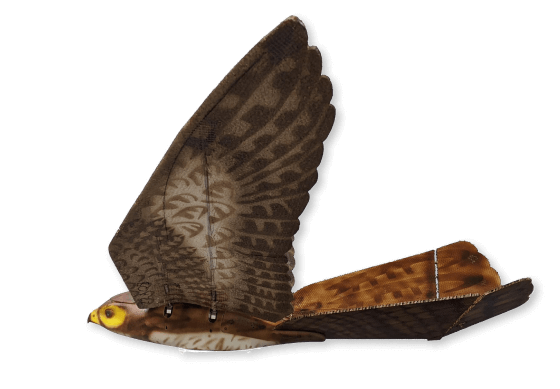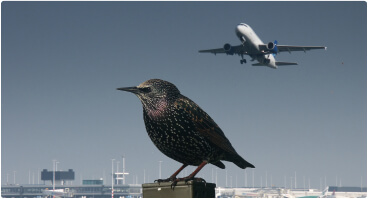Bird strikes involving military aircraft cause over US$75 million in damage annually in the U.S.
From assessing data and security threats to coordinating military personnel with developing drone technology, we are committed to collaboration with our security partners.
AERIUM’s drone solutions support air force bases across North America in maintaining safer airspace while providing highly innovative solutions to manage and improve safety and efficiency.
Utilizing our proprietary drone, RoBird® — along with our geospatial intelligence and automated data and surveillance capabilities — air force bases identify, assess, and mitigate potential hazards with great efficiency and results.
CBC reported that in 2020, a bird strike led to a fatal crash at a Canadian military snowbird demonstration in Kamloops, B.C.
Consider the following incidents involving bird strikes against military planes:
The most consistently effective bird hazing tool is a bird’s own natural enemy. RoBird® is a flapping-wing drone that mimics an actively hunting, female peregrine falcon.
Regarded as one of the most recognized and feared of all birds of prey around the globe, RoBird® naturally, humanely, and safely leverages the characteristics of the peregrine falcon to scatter and reduce bird populations near air force bases.
Supported by AERIUM’s advanced drone operating techniques RoBird® has proven to drastically reduce bird strike incidents.

The Military mandates explicit airport runway surface maintenance, approach path monitoring, and airport safety regulations. Military aircraft are more at risk to FOD damage.
Similar to the airport industry, significant time and resources are spent overseeing and upkeeping large areas of land to ensure regulatory compliance.
Foreign Object Debris (FOD) Detection and perimeter checks at a single airbase typically produce CO2 emissions equivalent to almost 35,000 litres of gasoline consumed.
On average the cost of Obstacle Limitation Surface (OLS) to a Canadian airbase is C$100,000 per inspection. Inspections also require runway closure which significantly adds to the induced cost.
Fast and hyper-accurate inspections, foreign object detection, and perimeter threat detection are now possible with advanced drone technology.
AERIUM supports the maintenance of safe and compliant military airbases utilizing Geospatial Intelligence and Data Automation and Surveillance drone technology solutions. Site and runway inspections are conducted by highly qualified and certified drone pilots utilizing high-resolution imagery and LiDAR.
Learn more about Geospatial Intelligence solutions:
Learn more about Data Automation and Surveillance solutions:

This demonstrates AERIUM’s ability to meet the needs of government when moving forward with projects that require high levels of security clearance.


There were several areas in which AERIUM solutions were proven to be valuable including wildlife management, FOD detection, and Runway Markings.
According to the Government of Canada, the National Defense Sector generates almost as much greenhouse gas emissions from real property and administrative fleet operations (543 kt) as all other federal departments combined.
AERIUM can help to drastically reduce these emissions by offering carbon-friendly drone solutions that can cover more inspections than a typical manned crew.
Driving the research, development, and commercialization of Beyond Visual Line of Sight (BVLOS) technology
Project SkySensus is just one of the ways in which AERIUM is partnering with key stakeholders to develop advancements and innovation of unmanned systems operations, airworthiness standards, and training, in addition to advancing the regulatory landscape in Canada.
Arcfield’s investment demonstrates a commitment to the future of aerospace and defense in Canada.
